Drop-Weight Impact Test on U-Shape Concrete Specimens with Statistical and Regression Analyses
Abstract
:1. Introduction
2. Experimental Program
2.1. Materials and Mix Proportions
| Oxide | SiO2 | A12O3 | CaO | MgO | SO3 | Fe2O3 | Loss on Ignition |
|---|---|---|---|---|---|---|---|
| Content(%) | 22.60 | 5.03 | 63.11 | 1.46 | 2.24 | 4.38 | 1.18 |
| Water | Cement | Coarse Aggregate | Fine Aggregate |
|---|---|---|---|
| 215 | 439 | 1118 | 629 |
2.2. Specimen Preparation
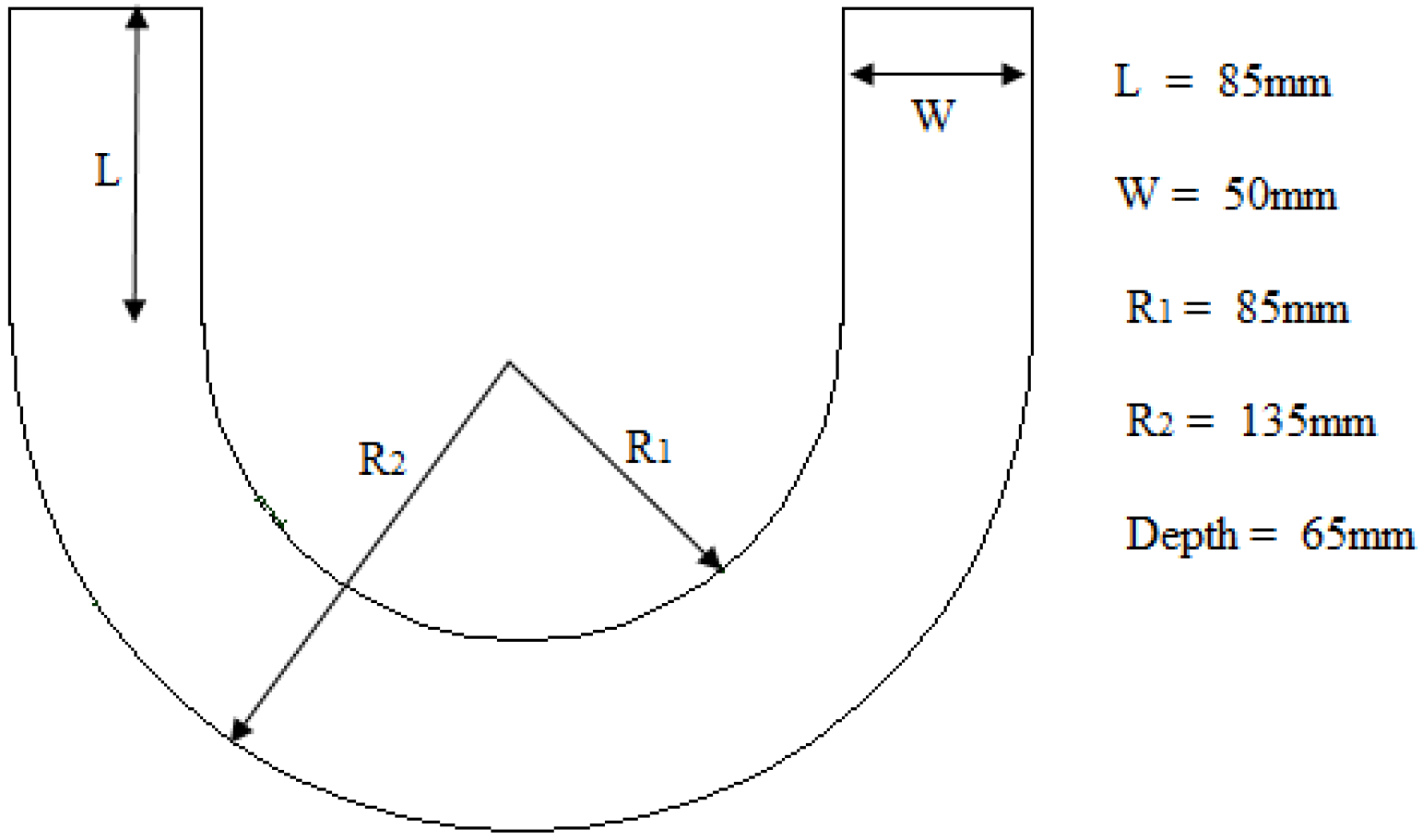
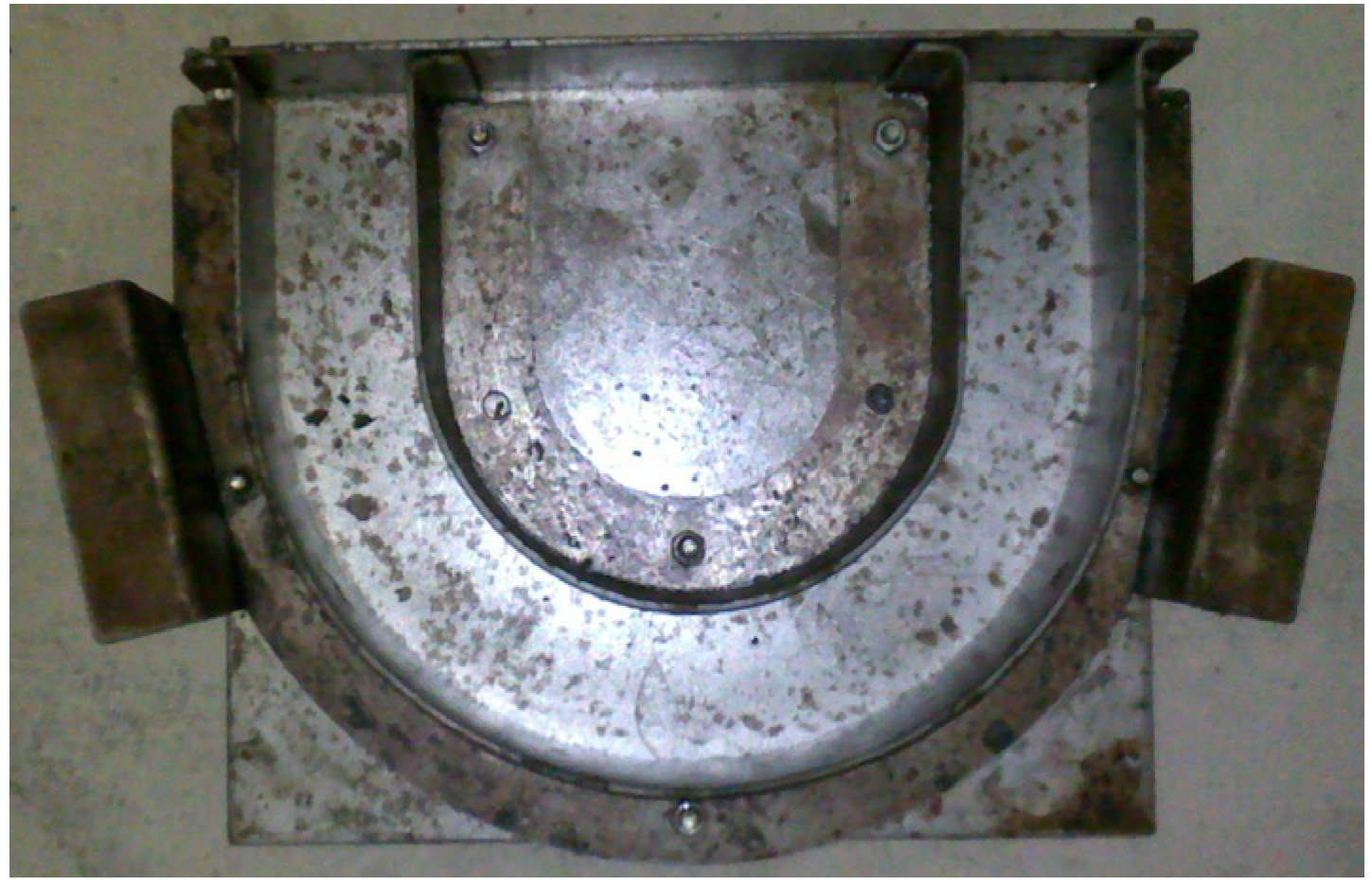
2.3. Test Procedures
2.3.1. Drop-Weight Impact Test

2.3.2. Compressive Strength Test
3. Results and Discussions
3.1. Compressive Strength Results
| Specimen Number | Compressive Strength (MPa) |
|---|---|
| 1 | 45.9 |
| 2 | 43.7 |
| 3 | 38.3 |
| 4 | 41.3 |
| 5 | 43.9 |
| 6 | 48.2 |
| 7 | 46.9 |
| 8 | 45.6 |
| 9 | 44.4 |
| 10 | 42.5 |
| 11 | 40.8 |
| 12 | 49.8 |
| Mean (x) | 44.3 |
| SD (σ) | 3.27 |
| COV (σ/x)% | 7.38 |
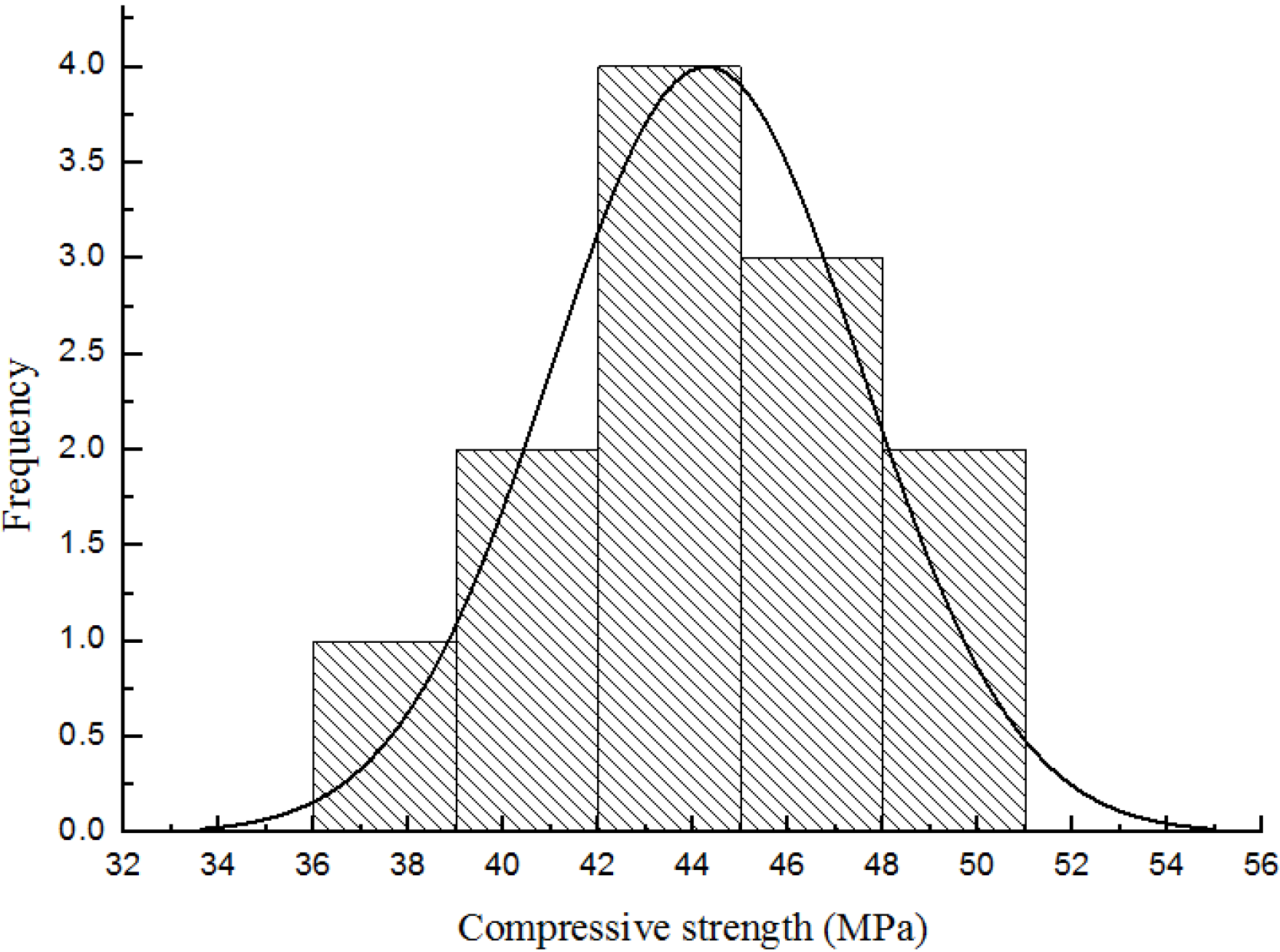
3.2. Drop-Weight Impact Test Results

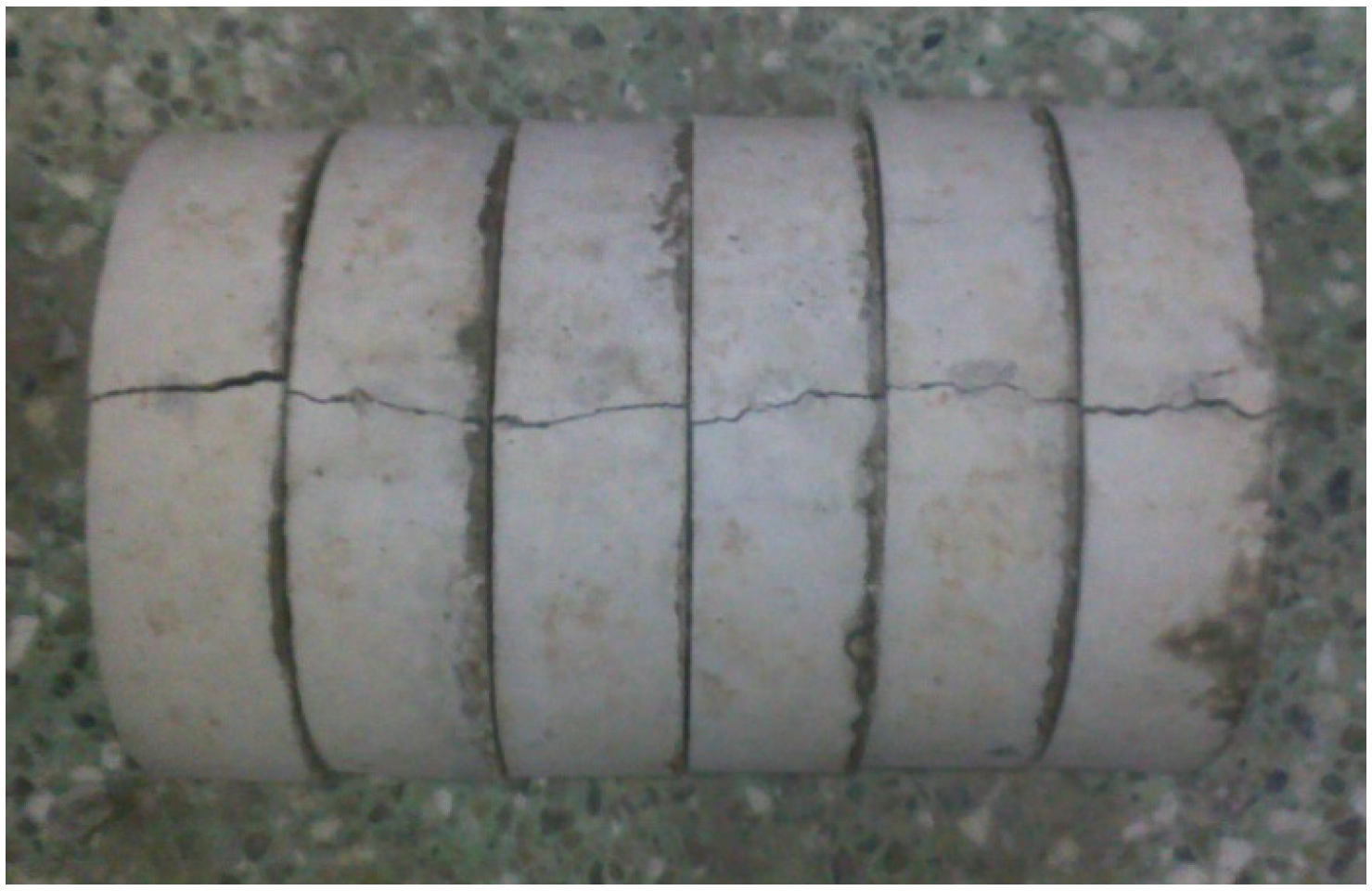
| Specimen Number | 0.875 kg | 0.8 kg | 0.675 kg | 0.5 kg | ||||
|---|---|---|---|---|---|---|---|---|
| N1 | N2 | N1 | N2 | N1 | N2 | N1 | N2 | |
| 1 | 16 | 24 | 38 | 45 | 138 | 163 | 236 | 269 |
| 2 | 18 | 27 | 49 | 56 | 160 | 173 | 251 | 277 |
| 3 | 8 | 12 | 23 | 28 | 85 | 106 | 182 | 218 |
| 4 | 20 | 25 | 60 | 68 | 121 | 130 | 293 | 338 |
| 5 | 17 | 23 | 31 | 40 | 136 | 146 | 308 | 347 |
| 6 | 19 | 28 | 36 | 42 | 172 | 189 | 169 | 185 |
| 7 | 18 | 26 | 43 | 52 | 196 | 213 | 269 | 296 |
| 8 | 15 | 20 | 51 | 56 | 117 | 134 | 257 | 283 |
| 9 | 9 | 15 | 31 | 40 | 96 | 112 | 229 | 251 |
| 10 | 16 | 23 | 29 | 36 | 136 | 156 | 257 | 289 |
| 11 | 25 | 37 | 65 | 79 | 134 | 158 | 223 | 256 |
| 12 | 12 | 17 | 40 | 47 | 156 | 172 | 285 | 306 |
| Mean (x) | 16 | 23 | 41 | 49 | 137 | 154 | 247 | 276 |
| SD (σ) | 4.7 | 6.6 | 12.8 | 14.2 | 31.1 | 31 | 41.9 | 45.8 |
| COV (σ/x)% | 29.4 | 28.7 | 31.2 | 29.0 | 22.7 | 20.1 | 17.0 | 16.6 |
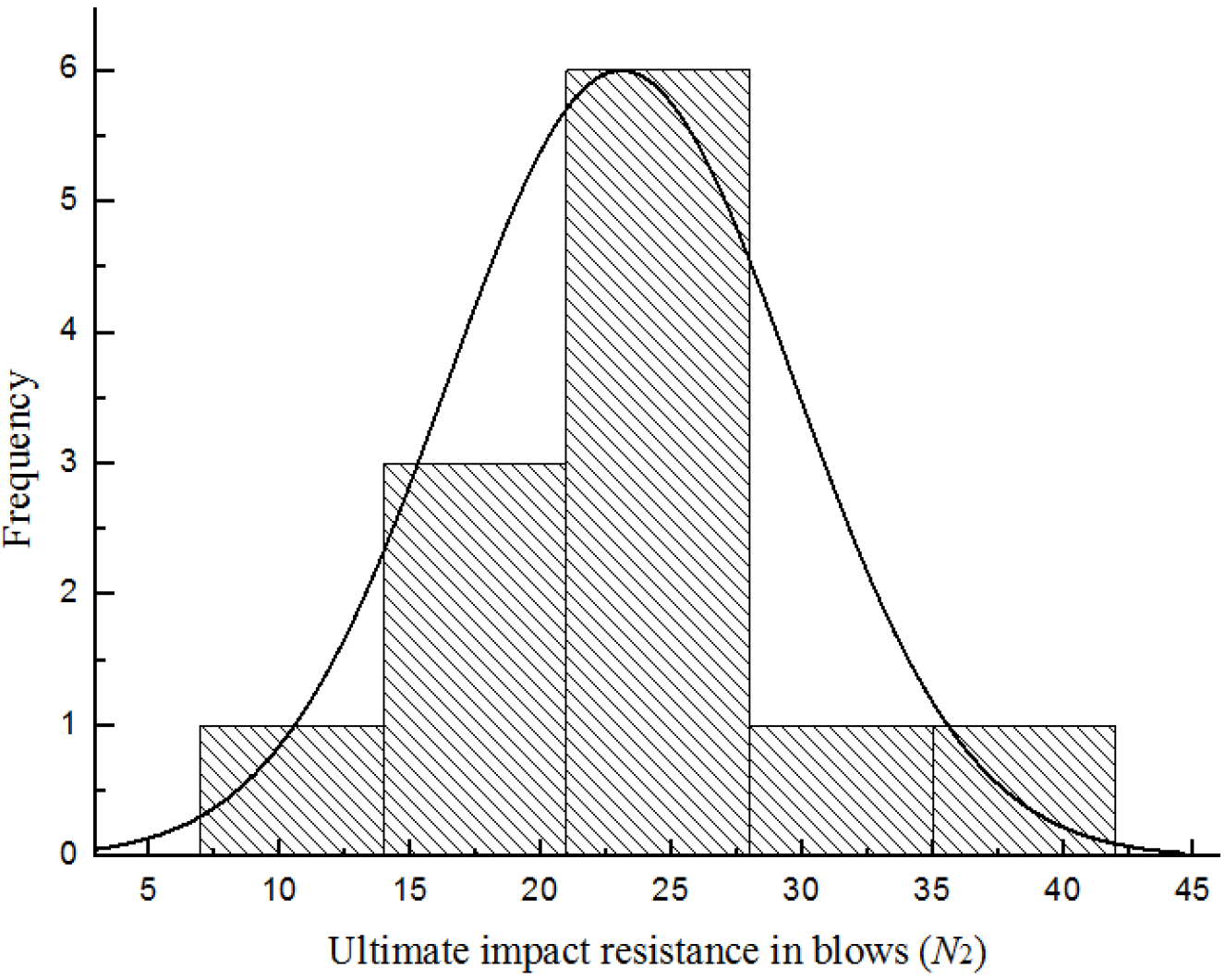
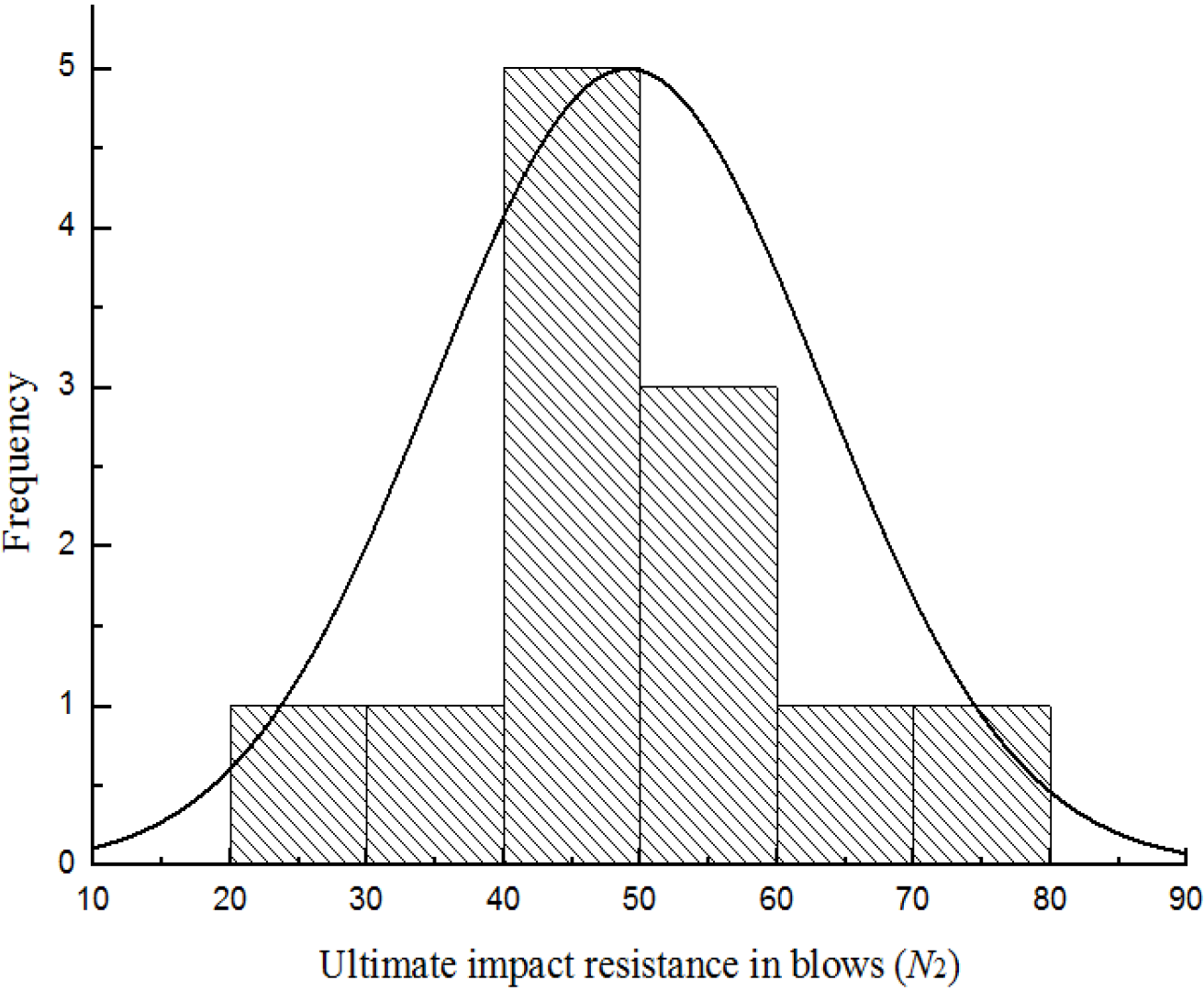


3.3. Regression Analysis
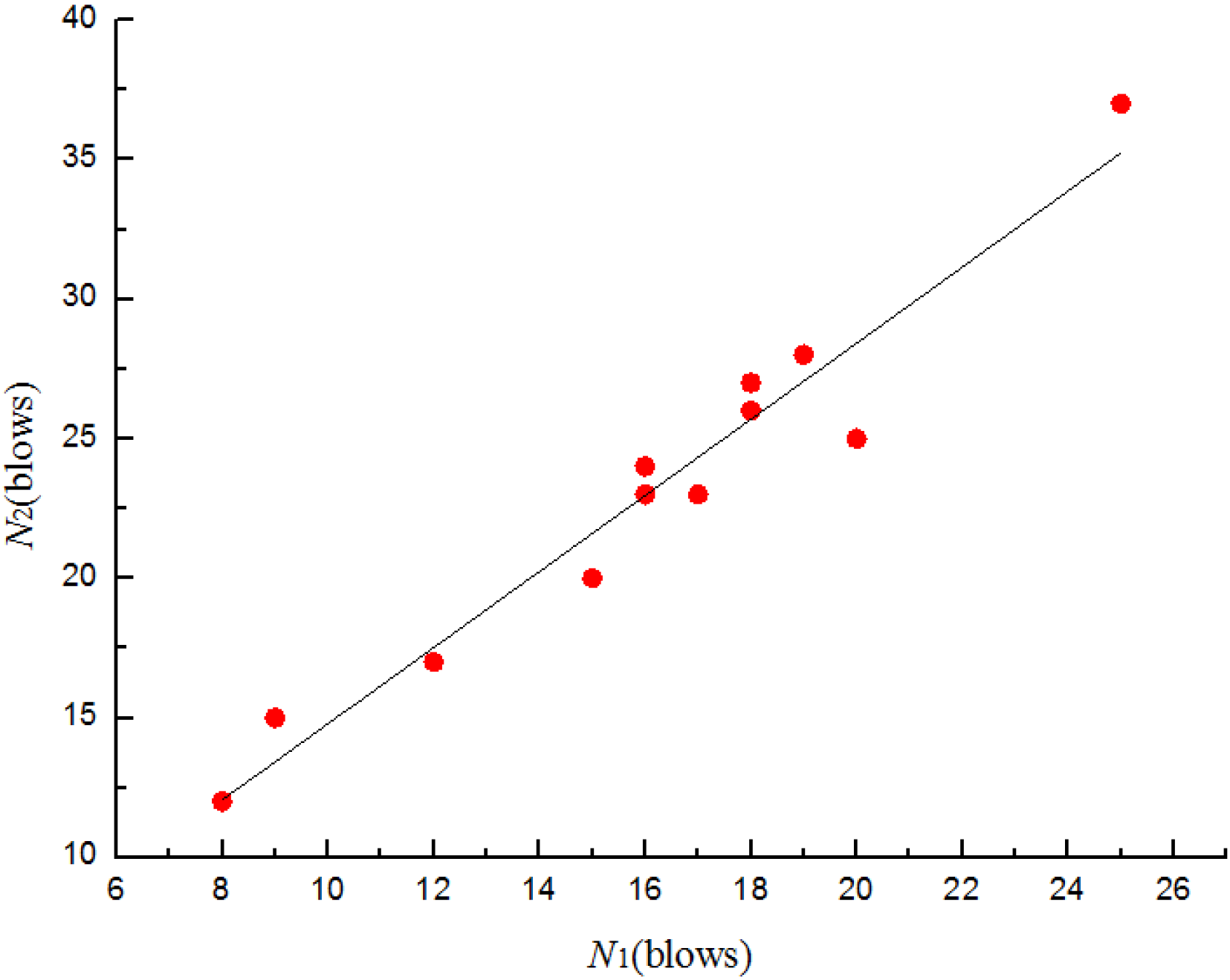
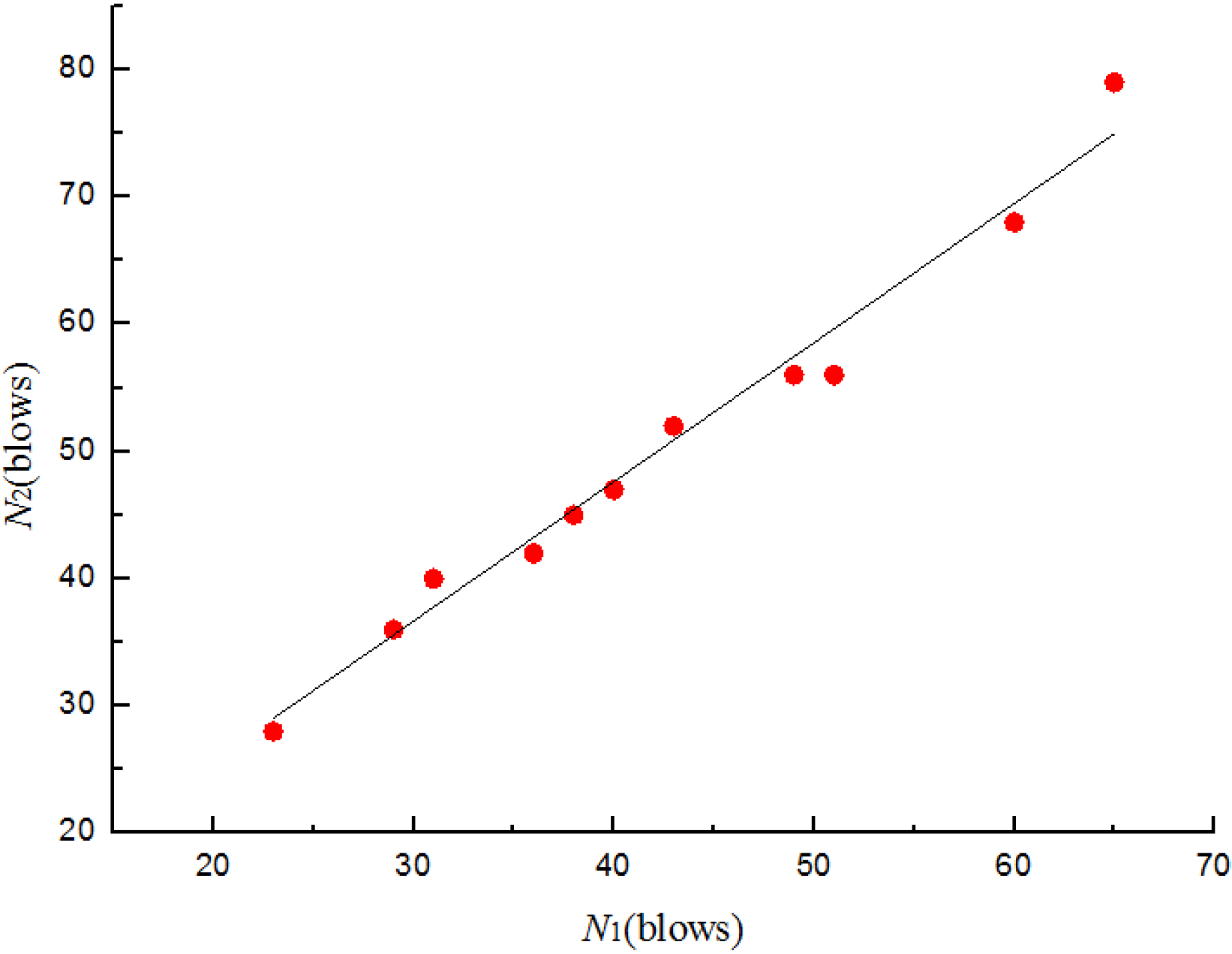
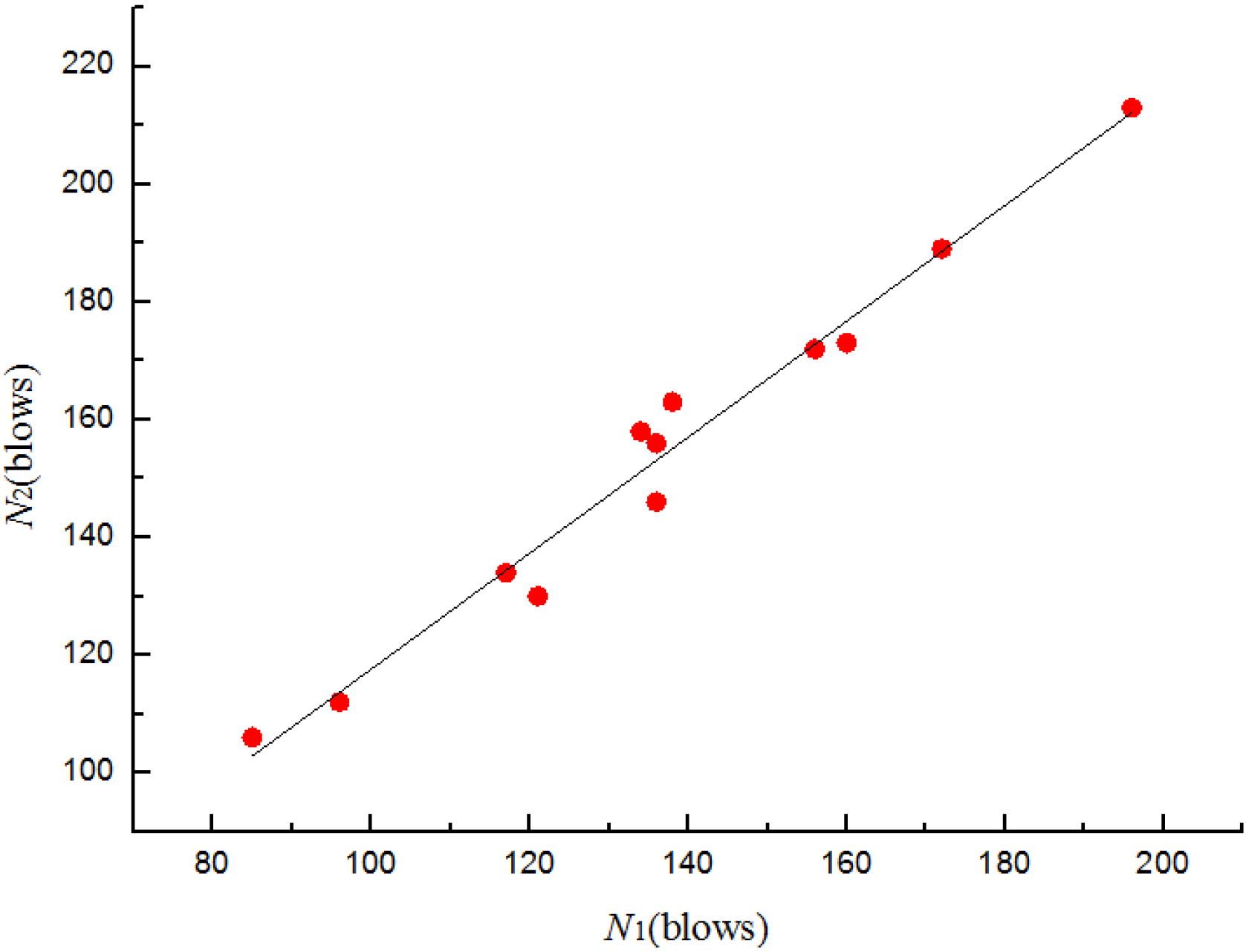
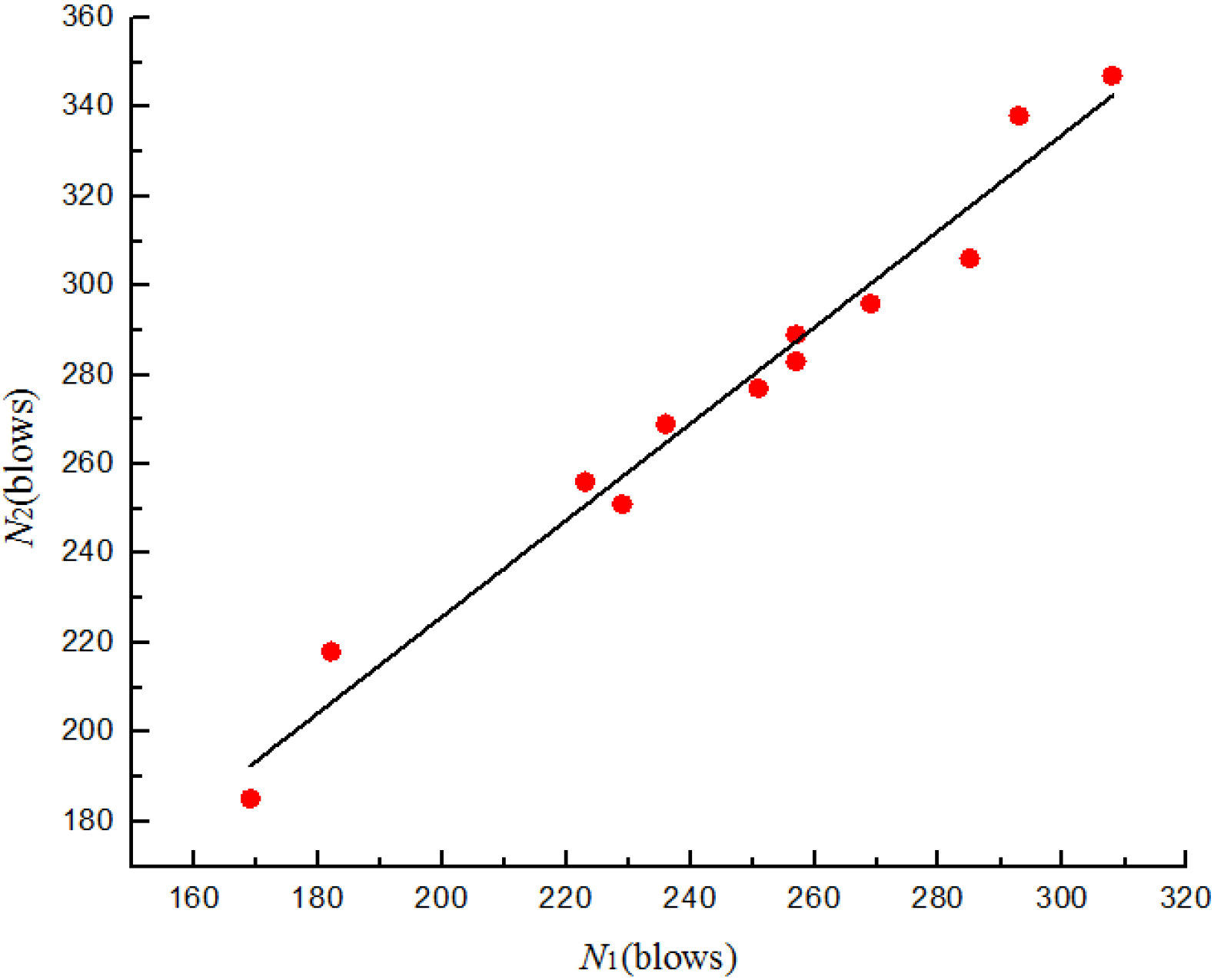
| Mass of Drop Hammer | a | b | R2 |
|---|---|---|---|
| 0.875 kg | 1.156 | 1.363 | 0.941 |
| 0.8 kg | 3.884 | 1.094 | 0.976 |
| 0.675 kg | 19.136 | 0.985 | 0.972 |
| 0.5 kg | 10.073 | 1.079 | 0.97 |
3.4. Minimum Number of Specimens
| Level of Confidence | Error (e%) | 0.875 Kg | 0.8 Kg | 0.675 Kg | 0.5 Kg | ||||
|---|---|---|---|---|---|---|---|---|---|
| N1 | N2 | N1 | N2 | N1 | N2 | N1 | N2 | ||
| 95% | <5 | 93 | 89 | 104 | 90 | 56 | 44 | 31 | 30 |
| <10 | 23 | 22 | 26 | 23 | 14 | 11 | 8 | 7 | |
| <15 | 10 | 10 | 12 | 10 | 6 | 5 | 4 | 3 | |
| <20 | 6 | 6 | 7 | 6 | 4 | 3 | 2 | 2 | |
| <25 | 4 | 4 | 4 | 3 | 2 | 2 | 1 | 1 | |
| <30 | 3 | 3 | 3 | 3 | 2 | 1 | 1 | 1 | |
| 90% | <5 | 56 | 54 | 63 | 55 | 34 | 27 | 19 | 18 |
| <10 | 14 | 13 | 16 | 14 | 9 | 7 | 5 | 5 | |
| <15 | 6 | 6 | 7 | 6 | 4 | 3 | 2 | 2 | |
| <20 | 4 | 3 | 4 | 3 | 2 | 2 | 1 | 1 | |
| <25 | 2 | 2 | 3 | 2 | 1 | 1 | 1 | 1 | |
| <30 | 2 | 2 | 2 | 2 | 1 | 1 | 1 | 1 | |
4. Conclusions
- Using U-shape specimens can force cracks to occur in a predefined path, and for each specimen, just a single crack occurred, which can facilitate observing the crack initiation and propagation. The newly designed drop-weight impact test apparatus is feasible and the operation is easy. It is also simple and intuitive to evaluate and compare the influence of different types of fibre reinforcement on the impact strength of concrete.
- The drop-weight impact test results showed good reproducibility with coefficients of variation in the range of 15%–30%. It was due partly to the use of U-shape specimens which predetermined the location of the crack.
- Four linear models have been suggested for four different impacting masses. In addition, the minimum number of specimens should be 23 and 14 at the 95% and 90% levels of confidence, in order to keep the error below 10%.
Acknowledgments
Author Contributions
Conflicts of Interest
References
- Xiao, S.; Li, H. Dynamic behavior and constitutive model of concrete at different strain rates. Mag. Concr. Res. 2008, 60, 271–278. [Google Scholar] [CrossRef]
- Rahmani, T.; Kiani, B.; Shekarchi, M.; Safari, A. Statistical and experimental analysis on the behavior of fiber reinforced concrete subjected to drop weight test. Constr. Build. Mater. 2012, 37, 360–369. [Google Scholar] [CrossRef]
- Shang, S.M. Experimental Study on Multi-Axial Dynamic Behavior of Plain Concrete. Ph.D. Thesis, Dalian University of Technology, Dalian, China, 2013. [Google Scholar]
- Gopalaratnam, V.S.; Shah, S.P.; John, R. A modified instrumented Charpy test for cement-based composites. Exp. Mech. 1984, 24, 102–111. [Google Scholar] [CrossRef]
- Barr, B.; Baghi, A. A repeated drop-weight impact testing apparatus for concrete. Mag. Concr. Res. 1988, 40, 167–176. [Google Scholar] [CrossRef]
- Ross, C.A.; Thompson, P.Y.; Tedesco, J.W. Split-hopkinson pressure-bar tests on concrete and mortar in tension and compression. Am. Concr. Inst. Mater. J. 1989, 86, 475–481. [Google Scholar]
- Mindess, S.; Yan, C. Perforation of plain and fibre reinforced concretes subjected to low-velocity impact loading. Cem. Concr. Res. 1993, 23, 83–92. [Google Scholar] [CrossRef]
- Ong, K.C.G.; Basheerkhan, M.; Paramasivam, P. Resistance of fibre concrete slabs to low velocity projectile impact. Cem. Concr. Compos. 1999, 21, 391–401. [Google Scholar] [CrossRef]
- Kishi, N.; Konno, H.; Ikeda, K.; Matsuoka, K.G. Prototype impact tests on ultimate impact resistance of PC rock-sheds. Int. J. Impact Eng. 2002, 27, 969–985. [Google Scholar] [CrossRef]
- American Concrete Institute. Measurement of Properties of Fiber Reinforced Concrete; ACI 544.2R-89; American Concrete Institute: Farmington Hills, MI, USA, 1999. [Google Scholar]
- ACI Committee 544. Measurement of properties of fiber reinforced concrete. Am. Concr. Inst. Mater. J. 1988, 85, 583–593. [Google Scholar]
- Badr, A.; Ashour, A.F.; Platten, A.K. Statistical variations in impact resistance of polypropylene fibre-reinforced concrete. Int. J. Impact Eng. 2006, 32, 1907–1920. [Google Scholar] [CrossRef]
- Song, P.S.; Wu, J.C.; Hwang, S.; Sheu, B.C. Assessment of statistical variations in impact resistance of high-strength concrete and high-strength steel fiber-reinforced concrete. Cem. Concr. Res. 2005, 35, 393–399. [Google Scholar] [CrossRef]
- Song, P.S.; Hwang, S.; Sheu, B.C. Strength properties of nylon- and polypropylene-fiber-reinforced concretes. Cem. Concr. Res. 2005, 35, 1546–1550. [Google Scholar] [CrossRef]
- Song, P.S.; Wu, J.C.; Hwang, S.; Sheu, B.C. Statistical analysis of impact strength and strength reliability of steel-polypropylene hybrid fiber-reinforced concrete. Constr. Build. Mater. 2005, 19, 1–9. [Google Scholar] [CrossRef]
- Nia, A.A.; Hedayatian, M.; Nili, M.; Sabet, V.A. An experimental and numerical study on how steel and polypropylene fibers affect the impact resistance in fiber-reinforced concrete. Int. J. Impact Eng. 2012, 46, 62–73. [Google Scholar]
- Schrader, E.K. Impact resistance and test procedure for concrete. Am. Concr. Inst. Mater. J. 1981, 78, 141–146. [Google Scholar]
- Zhang, Y. The Study on the Properties of Crumb Rubber Concrete with U-Shape Impact Test. Master’s Thesis, Tianjin University, Tianjin, China, 2011. [Google Scholar]
- China Standards Publication. Method of Testing Cements—Determination of Strength; GB/T 17671-1999; China Standards Press: Beijing, China, 1999. [Google Scholar]
- China Standards Publication. Sand for Construction; GB/T 14684-2011; China Standards Press: Beijing, China, 2011. [Google Scholar]
- China Standards Publication. Pebble and Crushed Stone for Construction; GB/T 14685-2011; China Standards Press: Beijing, China, 2011. [Google Scholar]
- China Standards Publication. Standard for Test Method of Performance on Ordinary Fresh Concrete; GB/T 50080-2002; China Standards Press: Beijing, China, 2003. [Google Scholar]
- China Standards Publication. Standard for Test Method of Mechanical Properties on Ordinary Concrete; GB/T 50081-2002; China Standards Press: Beijing, China, 2003. [Google Scholar]
- Day, K.W. Concrete Mix Design, Quality Control and Specification, 2nd ed.; E&FN Spon: London, UK, 1999. [Google Scholar]
- Swamy, R.N.; Stavides, H. Some statistical considerations of steel fibre reinforced composites. Cem. Concr. Res. 1976, 6, 201–216. [Google Scholar] [CrossRef]
- Ostle, B.; Tumer, K.V.; Hicks, C.R.; Mcelrath, G.W. Engineering Statistics: The Industrial Experience; Wadsworth Pub Co.: Belmont, CA, USA, 1996. [Google Scholar]
- Box, G.E.P.; Hunter, W.G.; Hunter, J.S. Statistics for Experimenters; John Willey: New York, NY, USA, 1978. [Google Scholar]
- Moore, D.S.; McCabe, G.P. Introduction to the Practice of Statistics; WH Freeman: New York, NY, USA, 1989. [Google Scholar]
© 2015 by the authors; licensee MDPI, Basel, Switzerland. This article is an open access article distributed under the terms and conditions of the Creative Commons Attribution license (http://creativecommons.org/licenses/by/4.0/).
Share and Cite
Zhu, X.-C.; Zhu, H.; Li, H.-R. Drop-Weight Impact Test on U-Shape Concrete Specimens with Statistical and Regression Analyses. Materials 2015, 8, 5877-5890. https://doi.org/10.3390/ma8095281
Zhu X-C, Zhu H, Li H-R. Drop-Weight Impact Test on U-Shape Concrete Specimens with Statistical and Regression Analyses. Materials. 2015; 8(9):5877-5890. https://doi.org/10.3390/ma8095281
Chicago/Turabian StyleZhu, Xue-Chao, Han Zhu, and Hao-Ran Li. 2015. "Drop-Weight Impact Test on U-Shape Concrete Specimens with Statistical and Regression Analyses" Materials 8, no. 9: 5877-5890. https://doi.org/10.3390/ma8095281





